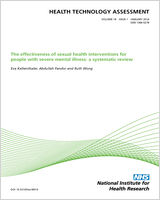Included under terms of UK Non-commercial Government License.
NCBI Bookshelf. A service of the National Library of Medicine, National Institutes of Health.
Salisbury C, Foster NE, Hopper C, et al. A pragmatic randomised controlled trial of the effectiveness and cost-effectiveness of ‘PhysioDirect’ telephone assessment and advice services for physiotherapy. Southampton (UK): NIHR Journals Library; 2013 Jan. (Health Technology Assessment, No. 17.2.)

A pragmatic randomised controlled trial of the effectiveness and cost-effectiveness of ‘PhysioDirect’ telephone assessment and advice services for physiotherapy.
Show detailsThe measures of satisfaction reported in Table 23 were derived from sets of questions given to patients at 6 weeks and 6 months. The questions items included:
- six questions about satisfaction with the consultation, based on questions used in the doctor and nurse versions of the General Practice Assessment Questionnaire
- three items about satisfaction with access (the hours the service was open, the length of time to wait for an appointment, and convenience of the service), which were issues identified through interviews with patients conducted for the pilot study for this trial, with the wording of the items also tested in that pilot study
- a single question about overall satisfaction with the physiotherapy service.
The first two sets of question items had response options on a Likert scale with values of 1–6, with a higher value indicating greater satisfaction. The overall satisfaction question had response options from 1–5, with a lower value being higher satisfaction. The direction of this question was reversed in reported results for consistency.
Excluding the overall satisfaction question item, the remaining nine questions were analysed by factor analysis to ensure that they formed coherent and distinct components of satisfaction in the study population. As the responses were on an ordinal scale, the analysis was conducted on the polychoric correlation matrix estimated on the response values. As shown in Table 65, the first two factors appeared to account for all of the variance.
TABLE 65
Factors from satisfaction questionnaire with estimates of their contributions to the total variance
Table 66 shows how the questions of the second set can be grouped, with the first six associated with one factor relating to the consultation and the remaining three with another factor linked to satisfaction with access to the service.
TABLE 66
Rotated factor loadings for the first two factors associated with satisfaction responses
For each of the two identified factors, consultation and access satisfaction, a mean score was recalculated on a scale from 0 to 100, as a percentage of the maximum possible score (i.e. a score of ‘0’ represents extreme dissatisfaction on all question items and ‘100’ represents extreme satisfaction on all items). The overall satisfaction score was transformed to the same scale.
- Development of patient satisfaction measure - A pragmatic randomised controlled ...Development of patient satisfaction measure - A pragmatic randomised controlled trial of the effectiveness and cost-effectiveness of ‘PhysioDirect’ telephone assessment and advice services for physiotherapy
Your browsing activity is empty.
Activity recording is turned off.
See more...